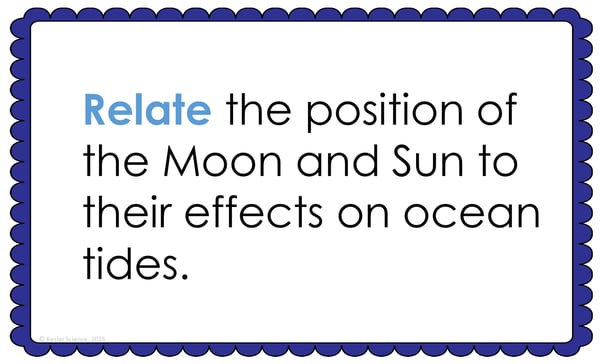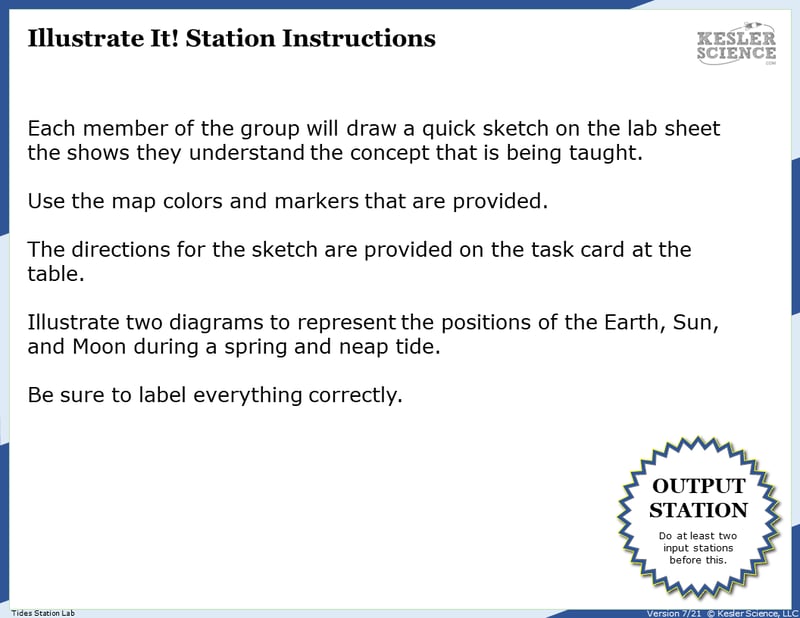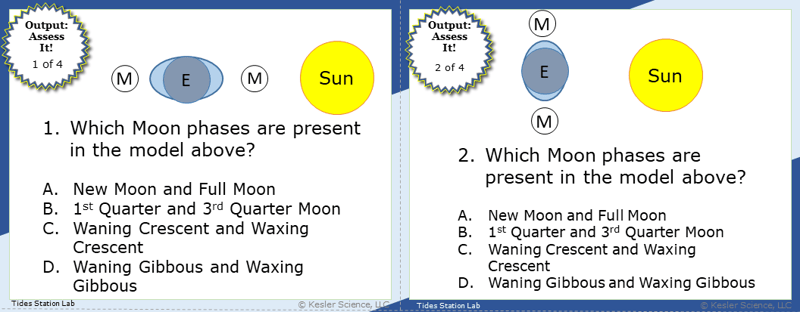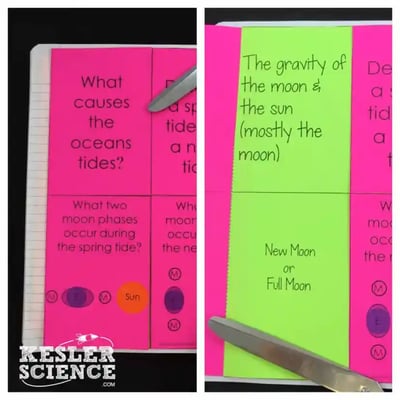Tides Lesson Plan – A Complete Science Lesson Using the 5E Method of Instruction
By the end of this comprehensive lesson about tides, students will be able to relate the position of the Moon and Sun to their effect on ocean tides. They'll also be able to determine the tides based on the position of the Sun, Earth and Moon and students will be able to characterize spring and neap tides. Each of our lessons is designed using the 5E method of instruction to ensure maximum comprehension by the students. This well-thought out unit does the heavy lifting, giving teachers easy-to-implement, highly engaging lesson plans.
This blog will walk you through each of the steps and activities from the Tides 5E Lesson Plan.
ENGAGEMENT
At the beginning of the lesson the class will discuss the objectives and some of the relevant vocabulary using the included objective statements and word wall cards.

The engagement activity continues with a with a short video clip and a Think-Pair-Share. Students will brainstorm in pairs to answer two questions about the cause of tides. Students will then be asked to share their ideas with the rest of the class. This activity will allow teachers to see where student have developed any misconceptions about how tides are formed.
Estimated Class Time for the Engagement: 20-30 minutes
EXPLORATION
A student-centered station lab is set up and the class will begin to explore why we have tides and what causes them. With nine stations in total, you can introduce tides to your middle school students in a variety of ways! Four of these stations are considered input stations where students will learn new information about tides, and four of the stations are output stations where students will be demonstrating their mastery of the lesson's material. A bonus station offers challenges for your early finishers and independent learners. You can read more about how I set up the station labs here.
Watch It!
At this station students will be watching a three minute long video about the formation of high, low, spring, and neap tides on Earth. There are three questions relating to the content which students will need to answer on their lab sheet.
Read It!
This station will provide students with a one-page reading about an area of coastline that is divided into four different zones. Students will then be asked four questions about the reading and will begin to understand how organisms have adapted to life based on the zone they inhabit and the tides that occur at different times throughout the year.
Explore It!
Students will be building a model of the Earth, Sun, and Moon to learn about why we have different tides on Earth relative to its position to the Sun and Moon. This station is set up to get students to explore the different positions of the Moon around the Earth and shows how the the Moon’s position is the determining factor for why there are two different kinds of tides that happen at different times throughout the year.
Research It!
The research station will allow students to get online and manipulate a computer model of the Moon’s revolution around the Earth and how its gravitation pull impacts the tides at different points on our planet. A series of questions will guide them through the activity as they begin to build a deeper understanding of why we have different tides.
Organize It!
The Organize It station allows your students to use a manipulable model to ensure their understanding of the different tides as the Moon rotates around the Earth and Sun.
Illustrate It!
Your visual students will love this station. Students will be drawing two diagrams of the Earth, Sun, and Moon and their positions during spring and neap tides.

Write It!
Students who can answer open-ended questions about the lab truly understand the concepts that they're being taught. At this station, the students will be answering three questions regarding why we have high and low tides, differences between spring and neap tides, and the role gravity plays on the tides.
Assess It!
The Assess It station is where students will go to prove mastery over the concepts they learned in the lab. The questions are set up in a standardized format with multiple choice answers. Some of the questions will have students looking at diagrams to determine the type of tide. Other questions will discuss moon phase based on position in the diagrams.

Challenge It! - Bonus Station
Early finishers and advanced students will love the extension activities in this station. Four activity choices offer them ways to expand their learning through mini-games and mini-projects.
Estimated Class Time for the Exploration: One or two 45-minute class periods
EXPLANATION
The explanation activities will become much more engaging for your class once they’ve completed the exploration station lab. During the explanation piece of the lesson, the teacher will be clearing up any misconceptions their students may have about tides with a variety of materials. These materials include on-level and modified versions of the interactive presentation (may be used individually or projected), anchor charts, and paper or digital interactive notebook activities. If you have students that need modified notes, the 5E lessons come equipped to help give every student access to the lesson.

Interactive notebook samples: Above-left is a digital INB activity slide; above-right is an example of the paper INB activities.
The students will also be interacting with their journals using INB templates for tides. Each INB activity is designed to help students compartmentalize information for greater understanding of the concept. The tides INB templates will challenge the students to understand what causes tides and what the sun, earth, and moon positions are during spring and neap tides.
Estimated Class Time for the Exploration: Two or three 45-minute class periods
ELABORATION
The elaboration section of the 5E method of instruction gives students choices that allow them to prove they’ve mastered the concepts behind the lesson. When students are given a choice, they’re much more enthusiastic and invested in the project than they are when their teachers choose their projects for them. There are a total of nine choices to demonstrate understanding of tides. A separate set of choices that offer more teacher support are also available for students that need them. Rubrics guide students to doing their best work and assist in grading.

Estimated Class Time for the Elaboration: Two or three 45-minute class periods (can also be used as an at-home project)
EVALUATION
The final piece of the 5E model is to evaluate student comprehension. Included in every 5E lesson is a homework assignment, assessment and modified assessment. Research has shown that homework needs to be meaningful and applicable to real-world activities in order to be effective. When possible, I like to give open-ended assessments to truly gauge the student’s comprehension.
Estimated Class Time for the Elaboration: One 45-minute class period
Download Over $100 in FREE Resources
For Middle School Science
Simply create a login below and gain immediate access to a selection of our Kesler Science product line worth $100 - for FREE. There's a full version of every product type! You'll also join tens of thousands of middle school science teachers who receive timely tips and strategies straight to their inbox.







